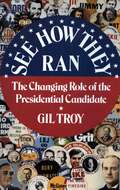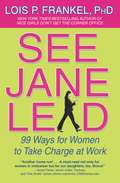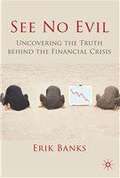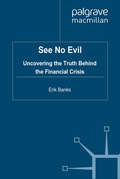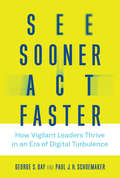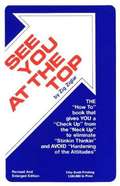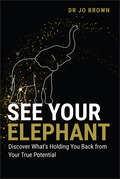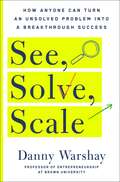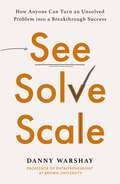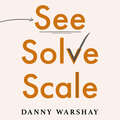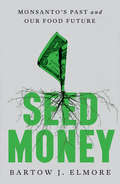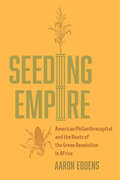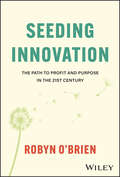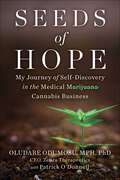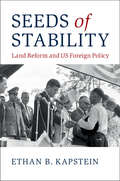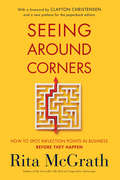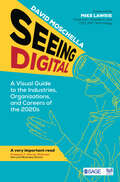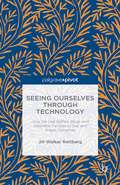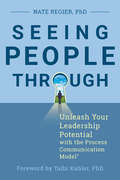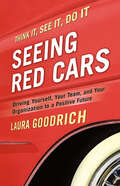- Table View
- List View
See How They Ran
by Gil TroySee How They Ran explores why candidates campaign as they do, why Americans complain about it, and what these evolving patterns and changing images tell us about American democracy itself.On the eve of every election, many Americans become convinced that this presidential campaign is worse than it has ever been. Frustrated, we long for the good old days of dignified campaigns and worthy candidates. However, as Gil Troy’s fascinating history demonstrates, they never existed. Originally, candidates did not run for office, but awaited the people’s call in dignified silence. When Stephen Douglas campaigned in 1860, he pretended to be visiting his mother as he traveled, not actively campaigning. In the post-1945 world, however, both Democratic and Republican candidates have stopped to kiss babies, donned hard hats, and pumped hands along the campaign trails. From the founding of our nation, Americans have wanted a leader who is simultaneously a man of the people and a man above the people. In See How They Ran, Troy shows that our disappointment with current presidential campaigns is simply the latest chapter in a centuries-long struggle to make peace with the idea of leadership in a democratic society. This is an engrossing and essential read.
See Jane Lead: 99 Ways for Women to Take Charge at Work (A NICE GIRLS Book)
by Lois P. FrankelThe workplace is changing. From the boardrooms to non-profit organizations to the military, the typical male management style is now obsolete. There is a new generation of employees who reject hierarchical leadership and respond to the behaviors and characteristics that women traditionally exhibit. In other words, the time for woment to take charge is now! In SEE JANE LEAD, Dr. Frankel provides a blueprint for women who want to tap their natural leadership abilities and manage with greater ease and confidence in the business world, on the soccer field, at home, and beyond. With the same sharp insight that she demonstrated in Nice Girls Don't Get Rich and Nice Girls Don't Get the Corner Office , Dr. Frankel shows women how they can overcome sabotaging childhood behaviors that hold them back, while offering practical advice and real-life examples of strong female leaders who have succeeded--in male dominated fields--beyond their wildest dreams.
See No Evil
by Erik BanksWe are doomed to experience further financial crises in the future, because money is powerful, bankers clever, political will malleable, and memories short. So argues Erik Banks in this brilliant book, which tells the story of the recent global economic crisis in the words of the main players in the drama. Banks shows how few bankers, regulators and politicians saw the crisis coming, and how they believed its effects would be containable when it began. When realization kicked in, they all began to compensate by talking loudly and designing populist knee-jerk measures which seemed only to deal with the specifics of preventing another crisis exactly like that which had already occurred. The form of future crises was barely thought about. Banks's reconstruction of the crisis, and the demonstration that so few substantive lessons have been learnt, is essential reading for anyone interested in our current predicament. "
See No Evil, Hear No Evil, Speak No Evil: The Policy Response to an Asset Market Bubble--The Fed Under Ben Bernanke
by Ethan S. HarrisOne of the most controversial questions in central banking is how policy makers should factor asset markets into their decision making. The toughest policy challenge comes in the extreme environment of a suspected asset price bubble or bust. Should a central bank step in to try to stop an unsustainable surge in asset prices? And, should the bubble burst, how long should a central bank wait before cutting interest rates? This chapter examines Ben Bernanke's approach.
See No Evil: Uncovering The Truth Behind The Financial Crisis
by E. BanksThe story of the recent global economic crisis is told in the words of the main players in the drama. Including quotes from bankers, rating agencies, housing agencies, regulators, politicians and media figures. Erik Banks' latest book shows why we are doomed to experience further financial crises in the future.
See Sooner, Act Faster: How Vigilant Leaders Thrive in an Era of Digital Turbulence (Management on the Cutting Edge)
by Paul J. Schoemaker George S. DayHow organizations can anticipate threats, spot opportunities, and act faster when the time is right; with rich examples including Adobe, MasterCard, and Amazon.When turbulence is the new normal, an organization's survival depends on vigilant leadership that can anticipate threats, spot opportunities, and act quickly when the time is right. In See Sooner, Act Faster, strategy experts George Day and Paul Schoemaker offer tools for thriving when digital advances intensify turbulence. Vigilant firms have greater foresight than their rivals, while vulnerable firms often miss early signals of external threats and organizational challenges. Charles Schwab, for example, was early to see and act on the promise of “robo-advisors”; Honeywell, on the other hand, stumbled when Nest Labs came out first with a “smart” thermostat. Day and Schoemaker show leaders how to assess their vigilance capabilities and cultivate insight and foresight throughout their organizations. They draw on a range of cases, including Adobe and Intuit's move to the cloud, Shell's investment in clean energy, and MasterCard's early recognition of digital challenges. Day and Schoemaker describe how to allocate the scarce resource of attention, how to detect weak signals and separate them from background noise, and how to respond strategically before competitors do. The challenge is not just to act faster but to act wisely, and the authors suggest ways to create dynamic portfolios of options. Finally, they offer an action agenda, with tips for fostering vigilance and agility throughout an organization. The rewards are stronger market positions, higher profits and growth, more motivated employees, and organization longevity.
See You At The Top
by Zig ZiglarTHE END Perhaps an unusual way to start a book - but this is an "unusual" book. It's about you, your family, your future, and how you can get more out of all of them by giving more to each of them. We believe that this is "the end," or at least the beginning of the end, of negative thinking, negative action, and negative reaction; the end of defeatism and despondency; the end of settling for less than you deserve to have and are capable of obtaining; the end of being influenced by little people, with little minds thinking little thoughts about the trivia that is the stock and trade of Mr. & Mrs. Mediocrity. In short, it is the end for you of the world's most deadly disease - "Hardening of the Attitudes." Welcome to The Richer Life.
See Your Elephant: Discover What's Holding You Back from Your True Potential
by Jo BrownOVERCOME DOUBTS AND SETBACKS — AND SMASH YOUR PERSONAL BEST What’s standing between you and greatness? It’s time to identify — and overcome — your own unique elephant in the room. See Your Elephant is your guide to uncovering and shattering your personal barriers so you can perform at your very best. Dr Jo Brown, a world-renowned performance coach and physiotherapist, has spent decades championing champions, guiding elite athletes and Olympians like Noah Lyles and Yohan Blake to peak performance. In this book, she shares invaluable insights that reveal how profound self-awareness and unbounded personal growth can help you redefine what’s possible and achieve your biggest, brightest goals. Discover how to: develop a growth mindsetidentify the limiting beliefs and habits holding you back apply proven techniques to overcome challengesbuild your self-awareness and find a way forwardaddress the elephant in your room. Greatness is a journey, not a destination. Whether you’re aiming for personal, career or even Olympic success, this book shares the life-changing strategies you need to break through your limits.
See Yourself as a System: Understanding the Internal and External Forces at Work on the Leader of Adaptive Change
by Alexander Grashow Marty Linsky Ronald HeifetzLike the organization you are trying to lead, you are a complex individual with competing interests and values, preferences and tendencies, aspirations and fears. As the authors suggest, you are a system. To understand your personal system, you have to take stock of your personality, life experiences, cognitive and other skills, and emotional makeup. You also need to appreciate that your behaviors and decisions stem not just from forces within yourself, but also from forces acting on you in any given organizational situation. By understanding which roles you play in your organization, you can identify the resources and constraints on your ability to make things happen. This chapter describes the many selves that constitute you--as a system. This chapter was originally published as chapter 13 of "The Practice of Adaptive Leadership: Tools and Tactics for Changing Your Organization and the World."
See, Solve, Scale: How Anyone Can Turn an Unsolved Problem into a Breakthrough Success
by Danny WarshayInspired by Brown University’s beloved course—The Entrepreneurial Process—Danny Warshay’s See, Solve, Scale is a proven and paradigm-shifting method to unlocking the power of entrepreneurship.The Entrepreneurial Process, one of Brown University’s highest-rated courses, has empowered thousands of students to start their own ventures. You might assume these ventures started because the founders were born entrepreneurs. You might assume that these folks had technical or finance degrees, or worked at fancy consulting firms, or had some other specialized knowledge. Yet that isn’t the case. Entrepreneurship is not a spirit or a gift. It is a process that anyone can learn, and that anyone can use to turn a problem into a solution with impact.In See, Solve, Scale, Danny Warshay, the creator of the Entrepreneurial Process course and founding Executive Director of Brown’s Center for Entrepreneurship, shares the same set of tools with aspiring entrepreneurs around the world. He overturns the common misconception that entrepreneurship is a hard-wired trait or the sole province of high-flying MBAs, and provides a proven method to identify consequential problems and an accessible process anyone can learn, master, and apply to solve them.Combining real-world experience backed by surprising research-based insights, See, Solve, Scale guides the reader through forming a successful startup team and through the three steps of the process: find and validate a problem, develop an initial small-scale solution, and scale a long-term solution. It also details eleven common errors of judgment that entrepreneurs make when they rely on their intuition and provides instruction for how to avoid them.Leveraging Warshay’s own entrepreneurship successes and his 15 years of experience teaching liberal arts students, See, Solve, Scale debunks common myths about entrepreneurship and empowers everyone, especially those who other entrepreneurship books have ignored and left behind. Its lasting message: Anyone can take a world-changing idea from conception to breakthrough entrepreneurial success.
See, Solve, Scale: How Anyone Can Turn an Unsolved Problem into a Breakthrough Success
by Professor Danny WarshayInspired by Brown University's beloved course - The Entrepreneurial Process - Danny Warshay's See, Solve, Scale is a proven and paradigm-shifting method to unlocking the power of entrepreneurship. The Entrepreneurial Process, one of Brown University's highest-rated courses, has empowered thousands of students to start their own ventures. You might assume these ventures started because the founders were born entrepreneurs. You might assume that these folks had technical or finance degrees, or worked at fancy consulting firms, or had some other specialized knowledge. Yet that isn't the case. Entrepreneurship is not a spirit or a gift. It is a process that anyone can learn, and that anyone can use to turn a problem into a solution with impact. In See, Solve, Scale, Danny Warshay, the creator of the Entrepreneurial Process course and founding Executive Director of Brown's Center for Entrepreneurship, shares the same set of tools with aspiring entrepreneurs around the world. He overturns the common misconception that entrepreneurship is a hard-wired trait or the sole province of high-flying MBAs, and provides a proven method to identify consequential problems and an accessible process anyone can learn, master, and apply to solve them. Combining real-world experience backed by surprising research-based insights, See, Solve, Scale guides the reader through forming a successful startup team and through the three steps of the process: find and validate a problem, develop an initial small-scale solution, and scale a long-term solution. It also details eleven common errors of judgment that entrepreneurs make when they rely on their intuition and provides instruction for how to avoid them. Leveraging Warshay's own entrepreneurship successes and his 15 years of experience teaching liberal arts students, See, Solve, Scale debunks common myths about entrepreneurship and empowers everyone, especially those who other entrepreneurship books have ignored and left behind. Its lasting message: Anyone can take a world-changing idea from conception to breakthrough entrepreneurial success.
See, Solve, Scale: How Anyone Can Turn an Unsolved Problem into a Breakthrough Success
by Professor Danny WarshayInspired by Brown University's beloved course - The Entrepreneurial Process - Danny Warshay's See, Solve, Scale is a proven and paradigm-shifting method to unlocking the power of entrepreneurship. The Entrepreneurial Process, one of Brown University's highest-rated courses, has empowered thousands of students to start their own ventures. You might assume these ventures started because the founders were born entrepreneurs. You might assume that these folks had technical or finance degrees, or worked at fancy consulting firms, or had some other specialized knowledge. Yet that isn't the case. Entrepreneurship is not a spirit or a gift. It is a process that anyone can learn, and that anyone can use to turn a problem into a solution with impact. In See, Solve, Scale, Danny Warshay, the creator of the Entrepreneurial Process course and founding Executive Director of Brown's Center for Entrepreneurship, shares the same set of tools with aspiring entrepreneurs around the world. He overturns the common misconception that entrepreneurship is a hard-wired trait or the sole province of high-flying MBAs, and provides a proven method to identify consequential problems and an accessible process anyone can learn, master, and apply to solve them. Combining real-world experience backed by surprising research-based insights, See, Solve, Scale guides the reader through forming a successful startup team and through the three steps of the process: find and validate a problem, develop an initial small-scale solution, and scale a long-term solution. It also details eleven common errors of judgment that entrepreneurs make when they rely on their intuition and provides instruction for how to avoid them. Leveraging Warshay's own entrepreneurship successes and his 15 years of experience teaching liberal arts students, See, Solve, Scale debunks common myths about entrepreneurship and empowers everyone, especially those who other entrepreneurship books have ignored and left behind. Its lasting message: Anyone can take a world-changing idea from conception to breakthrough entrepreneurial success.
Seed Money: Monsanto's Past And Our Food Future
by Bartow J. ElmoreAn authoritative and eye-opening history that examines how Monsanto came to have outsized influence over our food system. Monsanto, a St. Louis chemical firm that became the world’s largest maker of genetically engineered seeds, merged with German pharma-biotech giant Bayer in 2018—but its Roundup Ready® seeds, introduced twenty-five years ago, are still reshaping the farms that feed us. When researchers found trace amounts of the firm’s blockbuster herbicide in breakfast cereal bowls, Monsanto faced public outcry. Award-winning historian Bartow J. Elmore shows how the Roundup story is just one of the troubling threads of Monsanto’s past, many told here and woven together for the first time. A company employee sitting on potentially explosive information who weighs risking everything to tell his story. A town whose residents are urged to avoid their basements because Monsanto’s radioactive waste laces their homes’ foundations. Factory workers who peel off layers of their skin before accepting cash bonuses to continue dirty jobs. An executive wrestling with the ethics of selling a profitable product he knew was toxic. Incorporating global fieldwork, interviews with company employees, and untapped corporate and government records, Elmore traces Monsanto’s astounding evolution from a scrappy chemical startup to a global agribusiness powerhouse. Monsanto used seed money derived from toxic products—including PCBs and Agent Orange—to build an agricultural empire, promising endless bounty through its genetically engineered technology. Skyrocketing sales of Monsanto’s new Roundup Ready system stunned even those in the seed trade, who marveled at the influx of cash and lavish incentives into their sleepy sector. But as new data emerges about the Roundup system, and as Bayer faces a tide of lawsuits over Monsanto products past and present, Elmore’s urgent history shows how our food future is still very much tethered to the company’s chemical past.
Seeding Empire: American Philanthrocapital and the Roots of the Green Revolution in Africa
by Aaron EddensIn Seeding Empire, Aaron Eddens rewrites an enduring story about the past—and future—of global agriculture. Eddens connects today's efforts to cultivate a "Green Revolution in Africa" to a history of American projects that introduced capitalist agriculture across the Global South. Expansive in scope, this book draws on archival records of the earliest Green Revolution projects in Mexico in the 1940s and 1950s, as well as interviews at development institutions and agribusinesses working to deliver genetically modified crops to millions of small-scale farmers across Africa. From the offices of the Bill and Melinda Gates Foundation to the halls of the world's largest agricultural biotechnology companies to field trials of hybrid maize in Kenya, Eddens shows how the Green Revolution fails to address global inequalities. Seeding Empire insists that eradicating hunger in a world of climate crisis demands thinking beyond the Green Revolution.
Seeding Growth in the Democratic Republic of the Congo
by Carin-Isabel Knoop Ray A. Goldberg Djordjija PetkoskiBy 2013, the agricultural sector in the Democratic Republic of the Congo (DRC) had long suffered from war, political instability, and dilapidated infrastructure. A country with 75 million inhabitants and the second lowest GDP per capita in the world in 2011, the DRC's most pressing task was to grow its agriculture sector and cultivate its 80 million hectares of fertile land. This case explores how a developing country could create a comprehensive strategy to implement the necessary institutional, political, and social frameworks needed to support sustainable agricultural developments and rise out of long-term poverty.
Seeding Innovation: The Path to Profit and Purpose in the 21st Century
by Robyn O'BrienBuild and grow a company ready for the next generation of consumers In Seeding Innovation: The Path to Profit and Purpose in the 21st Century, veteran entrepreneur, award winning author, global strategist, speaker, and Rice University Innovation and Entrepreneurship professor, Robyn O’Brien, delivers an insightful and data driven roadmap to authenticity and smart leadership in the face of accelerating technological, environmental, and social change. In the book, you’ll discover how to build resilience, authenticity, market share and purpose into your business plan and move beyond box-ticking, virtue signaling and one-dimensional metrics, in a way that strengthens your business model, enhances your bottom line, attracts investors, fortifies employee retention, and more.With her characteristic candor and attention to data and deep experience on the frontlines of industry change, Robyn explains how you can transform concepts like paradigm blindness, scarcity, imposter syndrome, rejection, and fear to build durable, lasting, and profitable businesses that integrate social and environmental principles, with courage and integrity to drive long term shareholder and stakeholder value.You’ll also discover how to: Develop a purpose-driven product line that holds strong appeal for new generations of consumers and avoids the ruthless practices associated with PR nightmares and externalized costs Build an iconic company that focuses on integrating meaningful change to inspire customers, investors, and employees and that eschews meaningless press releases and virtue signaling Overcome imposter syndrome and naysayers using the S.T.O.P. Protocol ™ Develop supportive scaffolding and a resilient mindset in order to leverage courage and gain market share Build boards (not echo chambers), why equity and governance matters, and how diversity is good for your bottom line Integrate authentic marketing and storytelling into your brand strategy to drive revenue and capture market share Avoid the dangers of silos, fundraising traps and toxic capital and build a model with value-aligned, informed investors. Spot greenwashing, gender washing, and carbon washing, and more importantly, how to avoid them within your own organization and drive change Address headlines around ESG and DEI metrics in order to meet the needs of asset managers and investors, build successful teams and integrate goals that are central to outperformance and higher returns Gen Z and the modern consumer are looking for companies with authenticity—they want transparency and purpose from brands that are future proofing for the planet they’re inheriting. With this changing consumer focus and mindset emerges an urgent need for emotionally intelligent leadership. Along with profitability, 21st century leaders must focus on environmental stewardship, equity and justice, employee retention, recruiting, collaboration, and emerging other key aspects of modern business.
Seeding and Selling Asana
by Amram Migdal Jeffrey Rayport Susie L. MaIn December 2019, Oliver Jay, Asana's Chief Revenue Officer (CRO), was reconsidering his go-to-market (GTM) strategy. Asana was cloud-based work management software that enabled users to break up projects into discrete tasks that could be assigned, scheduled, and tracked on a single, integrated platform. Jay was wondering how to increase annual recurring revenue by year-end 2020. Just three years earlier, when Jay joined Asana as its first CRO, thousands of companies were already using free and paid versions of its software. Since Asana was a software-as-a-service (SaaS) offer, all a new user needed to do was to create an account. This meant individual users and teams could onboard easily and initially for free, using an array of self-service tools, without purchasing approval from their IT departments on conversion to paid subscriptions and without initial sales support from Asana. This mix of free and paid users proved sustainable and profitable for Asana. However, reaching senior directors, vice presidents, and executives of potential client companies to drive larger, enterprise-wide adoptions was a challenge for the Asana sales team. Jay's desire to improve sales performance led him to a novel concept: to structure the sales team based on where customers were in their adoption cycles with Asana-that is, to organize sales by stages of the customer journey rather than by the time-honored approach of organizing by account size (e.g., SMB, mid-market, and enterprise). Was this radical idea the right structure for Asana to reach its revenue growth goals - or was it fraught with too much risk?
Seeds of Hope: My Journey of Self-Discovery in the Medical Cannabis Business
by Patrick O'Donnell Dr. Oludare OdumosuAn immigrant's story of leadership, innovation, and humanity in cannabis medicine.Seeds of Hope is an eye-opening memoir of self-discovery and entrepreneurship set against a backdrop of the war on drugs. It&’s also a story of the transformative power of medical cannabis and its potential to revolutionize the healthcare industry. Written by Dr. Oludare Odumosu, MPH, PhD, it takes readers on a personal journey as he progresses from &“just say no&” to become one of the leading voices in the global cannabinoid space. Dr. Odumosu explores the history of cannabis and the devastating effects of the War on Drugs on cannabis medicine, addiction, and the minority community. He shares his personal experience in cannabis medicine and entrepreneurship, including fears, frustrations, and triumphs, as he and his team run an ever-changing gauntlet of state and federal rules and regulations.Seeds of Hope is a must-read for anyone interested in the transformative power of medical cannabis, including aspiring entrepreneurs. It&’s also an inspiring memoir that offers hope, insights, and lessons learned on leadership, success, and achieving one&’s dreams.
Seeds of Resistance: The Fight to Save Our Food Supply
by David Talbot Mark SchapiroSun. Soil. Water. Seed. These are the primordial ingredients for the most essential activity of all on earth: growing food. All of these elements are being changed dramatically under the pressures of corporate consolidation of the food chain, which has been accelerating just as climate change is profoundly altering the conditions for growing food. In the midst of this global crisis, the fate of our food has slipped into a handful of the world’s largest companies. Food Chained will bring home what this corporate stranglehold is doing to our daily diet, from the explosion of genetically modified foods to the rapid disappearance of plant varieties to the elimination of independent farmers who have long been the bedrock of our food supply.Food Chained will touch many nerves for readers, including concerns about climate change, chronic drought in essential farm states like California, the persistence of the junk food culture, the proliferation of GMOs, and the alarming domination of the seed market and our very life cycle by global giants like Monsanto.But not all is bleak when it comes to the future of our food supply. Food Chained will also present hopeful stories about farmers, consumer groups, and government agencies around the world that are resisting the tightening corporate squeeze on our food chain.
Seeds of Stability: Land Reform and US Foreign Policy
by Kapstein Ethan B.Under what conditions do the governments of developing countries manage to reform their way out of political and economic instability? When are they instead overwhelmed by the forces of social conflict? What role can great powers play in shaping one outcome or the other? This book is among the first to show in detail how the United States has used foreign economic policy, including foreign aid, as a tool for intervening in the developing world. Specifically, it traces how the United States promoted land reform as a vehicle for producing political stability. By showing where that policy proved stabilizing, and where it failed, a nuanced account is provided of how the local structure of the political economy plays a decisive role in shaping outcomes on the ground.
Seeing Around Corners: How to Spot Inflection Points in Business Before They Happen
by Rita McGrathThe first prescriptive, innovative guide to seeing inflection points before they happen—and how to harness these disruptive influences to give your company a strategic advantage.Paradigmatic shifts in the business landscape, known as inflection points, can either create new, entrepreneurial opportunities (see Amazon and Netflix) or they can lead to devastating consequences (e.g., Blockbuster and Toys R Us). Only those leaders who can “see around corners”–that is, spot the disruptive inflection points developing before they hit–are poised to succeed in this market. Columbia Business School Professor and corporate consultant Rita McGrath contends that inflection points, though they may seem sudden, are not random. Every seemingly overnight shift is the final stage of a process that has been subtly building for some time. Armed with the right strategies and tools, smart businesses can see these inflection points coming and use them to gain a competitive advantage. Seeing Around Corners is the first hands-on guide to anticipating, understanding, and capitalizing on the inflection points shaping the marketplace.
Seeing Digital: A Visual Guide to the Industries, Organizations, and Careers of the 2020s
by David MoschellaThe Post-Cloud era has already begun. A powerful wave of new technologies—machine learning, smart products, software agents, wearables, blockchains, speech/facial recognition, robotics, augmented realities, algorithms, and 5G wireless bandwidth—is creating a digital world that is pervasive, embedded, aware, and autonomous. Seeing Digital uses a unique visual format to illustrate how these exciting innovations will transform the industries, organizations, and careers of the 2020s. Insight-packed chapters assess the myths and realities of industry disruption, the necessity of machine intelligence, the importance of platform business models, and the challenges of digital transformation, leadership, and risk. This wide-ranging book also forecasts the coming battle between Silicon Valley and China, how innovation is shifting to the Human Platform, the future of the Enterprise IT function, and technology’s overall impact on jobs, skills, and society. With its easy to read, picture-per-page design, Seeing Digital will help you literally see our technology driven future.
Seeing Ourselves Through Technology: How We Use Selfies, Blogs and Wearable Devices to See and Shape Ourselves
by Jill W. RettbergThis book is open access under a CC BY license. Selfies, blogs and lifelogging devices help us understand ourselves, building on long histories of written, visual and quantitative modes of self-representations. This book uses examples to explore the balance between using technology to see ourselves and allowing our machines to tell us who we are.
Seeing People Through: Unleash Your Leadership Potential with the Process Communication Model®
by Nate Regier, PhDNASA, Pixar Animation Studios, and BMW all use the Process Communication Model as a way of training leaders to connect effortlessly with anyone. This book simplifies the complex model to make it easy for anyone to use.Today, more than ever, leaders need a new style of leadership. They are realizing that true transformation happens through meaningful relationships, and discovering that the key to sustainable connections that create possibility and potential is through communication.In Seeing People Through, we take a deep dive into The Process Communication Model (PCM), a behavioral communication model that teaches people how to assess, connect, motivate, and resolve conflict by understanding the personality types that make up a person's whole self, which is the key to leveraging personality diversity.PCM is more than a lens for understanding how people see things differently; it's a deep journey into self-awareness and self-transformation. In this book, new emerging leaders, senior leaders, and seasoned consultants alike will develop a fresh and relevant framework on leadership that is consistent with emerging trends, and they will learn how individual and collective concerns can be reconciled in leadership.NASA, Pixar Animation Studios, and BMW are just some of the companies who have all used PCM as a way to build better relationships through authenticity, trust, agility, and positive influence-and now you can, too!
Seeing Red Cars: Driving Yourself, Your Team, and Your Organization to a Positive Future
by Laura GoodrichSurely you’ve experienced something like this: you buy a red car, and suddenly red cars appear everywhere. Why? Because you’re focusing on red cars—and you get more of whatever you focus on. But much of the time, consciously and unconsciously, we dwell on what we don’t want, and that’s what we get. Drawing on the latest scientific research, Laura Goodrich shows you how to stop fixating on negatives and rewire your brain to focus on positive outcomes. Unique and practical exercises—including a free online toolkit—and dozens of enlightening real-life stories help you identify what you truly want so that it drives everything you do. And Goodrich shows how Seeing Red Cars can build organizational cultures in which employees are playing to their passions and strengths, focusing on what they want, and achieving breakthrough results.
